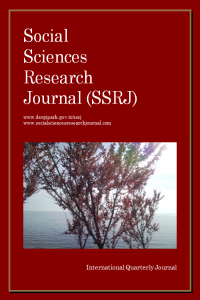İlkokul Öğrencilerinin Bilim ve Bilim İnsanına İlişkin Algıları
bilim, bilim insanı, ilkokul
The Perceptions of Primary School Students on Science and Scientist
science, scientist, primary school,
___
- Ağgül Yalçın, F. (2012). Investigation of prospective teachers’ ımage of scientist with respect to some variables. Elementary Education Online, 11(3), 611-628.
- Bağ, H. (2013). 4. ve 5. Sınıf Öğrencilerinin Bilim İnsanı İmajları (Yüksek Lisans Tezi). Recep Tayyip Erdoğan Üniversitesi, Rize.
- Balkı, N., Çoban, K. ve Aktaş, M. (2003). İlköğretim öğrencilerinin bilim ve bilim insanına yönelik düşüncleri. Uludağ Üniversitesi Eğitim Fakültesi Dergisi, 17(1), 11–17. Retrieved from http://ucmaz.home.uludag.edu.tr/PDF/egitim/htmpdf/2003-16(1)/MK-2.pdf
- Bayram, E. B. (2018). İlkokul 4. Sınıf öğrencilerinin Bilim İnsanı İmajları ve Bu İmajların Oluşmasında Ders Kitapları ve Öğretmenlerin Rolü (Yüksek Lisans Tezi). Bayburt Üniversitesi Sosyal Bilimler Enstitüsü, Bayburt.
- Buldu, M. (2006). Young children’s perceptionsof scientists: A preliminary study. 61 Educational Research, 48(1), 121-132
- Creswell, J.W. (2013). Nitel araştırma yöntemleri: Beş yaklaşıma gore nitel araştırma ve araştırma deseni(3. Baskıdan Çeviri). (Çeviri Editörleri: M. Bütün &S.B.Demir). Ankara: Siyasal Yayın Dağıtım.
- Doğan, H. (2015). Farklı ülkelerden 11-13 yaş aralığındaki öğrencilerin bilim ve bilim insanı hakkındaki görüşleri (Yüksek Lisans Tezi) Akdeniz Üniversitesi Eğitim Bilimleri Enstitüsü, Antalya.
- Erkorkmaz, Z. (2009). İlköğretim I. kademe öğrencilerinin bilim insanına ilişkin görüşlerinin belirlenmesi (Yüksek Lisans Tezi) Süleyman Demirel Üniversitesi Fen Bilimleri Enstitüsü, Isparta.
- Gonsoulin, W. B. (2001). How Do Middle School Students Depict Science and Scientist. Mississippi State University, Curriculum and Instruction, Doctoral Thesis, UMI Number: 3005589.
- Güler, T., ve Akman, B. (2006). 6 yaş çocuklarının bilim ve bilim insanı hakkındaki görüşleri. Hacettepe Üniversitesi Eğitim Fakültesi Dergisi, 31, 55–66.
- Işıkdere, A. (2016). Çouk ve bilim. Retrieved January 13, 2018, from https://isikdere.wordpress.com/2016/04/22/cocuk-ve-bilim/
- Kaya, O.N., Doğan, A. ve Öcal, E., Turkish Elementary School Students’ Images of Scientists (2008) Eurasian Journal of Educational Research, 32, 83–100.
- Korkmaz, H. ve Kavak, G. (2010) İlköğretim öğrencilerinin bilime ve bilim insanına yönelik imajları, Elementary Education Online 9(3), 1055–1079.
- Merriam, S. B. (2013). Nitel araştırma: Desen ve uygulama için bir rehber(3. Baskıdan Çeviri, Çeviri Editörü: S. Turan). Ankara: Nobel Yayın Dağıtım.
- Nuhoğlu, H. & Afacan, Ö. (2007). İlköğretim Öğrencilerinin Bilim İnsanına Yönelik Düşüncelerinin Değerlendirilmesi. 16. Ulusal Eğitim Bilimleri Kongresi, 05-07 Eylül 2007, Tokat
- Nuhoğlu, H., ve Afacan, Ö. (2011). İlköğretim öğrencilerinin bilim insanına yönelik düşüncelerinin değerlendirilmesi. Ahi Evran Üniversitesi Eğitim Fakültesi Dergisi, 12(3), 279–298.
- Osborne, J., & Dillon, J. (2008). Science education in europe: critical reflections a report to the nuffield foundation. Retrieved from http://efepereth.wdfiles.com/local--files/science-education/Sci_Ed_in_Europe_Report_Final.pdf
- Özel, M. (2012). Children’s ımages of scientists: does grade level make a difference? *. Kuram ve Uygulamada Egitim Bilimleri, Educational Sciences: Theory& Practice 12(SUPPL. 4), 3187–3198. Retrieved from www.edam.com.tr/estp
- Özgelen, S. (2012). Turkish young children ’ s views on science and scientists. Educational sciences: Theory & Practice - Special Issue, 12(4), 3211–3225. Retrieved from www.edam.com.tr/estp
- Özsoy, S., ve Ahi, B. (2014). Images of scientists through the eyes of the children summary problem statement. Necatibey Faculty of Education Electronic Journal of Science and Mathematics Education, 8(1), 204–230. https://doi.org/10.12973/nefmed.2014.8.1.a9
- Simsek, C.L. (2009). How much and how science and technology curriculums and textbooks benefits from history of science ? Fen ve Teknoloji Dersi Öğretim Programları ve Ders Kitapları Bilim Tarihinden Ne Kadar ve Nasıl Yararlanıyor ?, Elementary Education Online 8(1), 129–145.
- Toğrol, A. (2000). Öğrencilerin bilim ınsanları ıle ılgili ımgeleri. Eğitim Bilim, 25(118). Retrieved from http://egitimvebilim.ted.org.tr/index.php/EB/article/view/5302
- Türkmen, H. (2008). Turkish primary students’ perceptions about scientist and what factors affecting the ımage of the scientists. Eurasia Journal of Mathematics Science & Technology Education, 4(1), 55–61. Retrieved from http://media.tripod.lycos.com/2962912/1555318.pdf
- Yıldırım, A. & Şimşek, H. (2011). Sosyal bilimlerde nitel araştırma yöntemleri (8.baskı). Ankara: Seçkin Yayıncılık.
- Yayın Aralığı: Yılda 4 Sayı
- Yayıncı: Denta Florya ADSM Limited Company
Yasemin KOLDERE AKIN, Cenk TURAN
Hatice KÜÇÜKKAYA, Sinem DÜNDAR
İlkokul Öğrencilerinin Bilim ve Bilim İnsanına İlişkin Algıları
2008 Krizi Sonrası Avrupa Birliği’nde Toplu Pazarlık: Fransa ve Romanya
Semra ELVANESENTÜRK, Semra TETİK
Bilgi İletişim Teknolojileri (ICT) Yayiliminin Faiz Oranlarina Etkisi: Panel Analiz
Seyfettin ÜNAL, Cüneyt KOYUNCU
Ücret Denklemlerinin Tahmininde Pseudo Panel Veri Yaklaşımı
Karar Ağacı Algoritmaları ve Çocuk İşçiliği Üzerine Bir Uygulama
Şeyda DEMİREL, Selay GİRAY YAKUT
Trakya Bölgesinde İkinci Basamak Kamu Sağlık Hizmetlerinde Yaşlı Refahı
